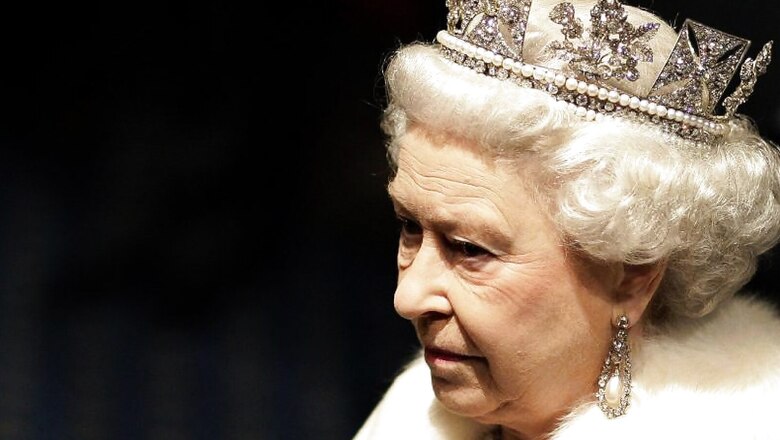
views
The death of the world’s longest-ruling monarch, Queen Elizabeth II reignited the debate on colonialism. While many have mourned the death of the empress, the empire and its legacy, however, have rubbed many wounds, especially in South Asian and African nations that have been on the receiving ends of the monarchy.
The British royal family has been linked to the colonization of many countries across the world including India. The colonial empire for the ‘subjects’ under the rule was a period of oppression, forced labour, and slavery.
Elizabeth II was crowned queen of the United Kingdom in 1952, just five years after India and Pakistan gained independence from British colonial rule. At the time when the young Elizabeth got to know that she will be crowned as the Queen, she was in Kenya, another ‘subject’ of colonial rule.
At the time she headed the monarchy, it was already in a declining stage with many nations like India seeking Independent rule. She inherited and sustained an imperial monarchy by assuming the title of head of the Commonwealth.
What is Common Wealth?
Despite the decline of the empire, the commonwealth became a common room for almost all of the nations ruled by the British outside of the UK.
The UK govt considers a commonwealth as a realm of countries which has the Queen as its Monarch. There are 14 Commonwealth Realms in addition to the UK. Initially, Commonwealth countries were not considered to be foreign to each other as their citizens were considered British subjects.
During one of her addresses to Canada Queen Elizabeth II in 1959, said that the confederation of Canada on 1 July 1867 had been the birth of the “first independent country within the British Empire”. She declared: “So, it also marks the beginning of that free association of independent states which is now known as the Commonwealth of Nations.”
It was originally created as the British Commonwealth of Nations but with increasing decolonization of the British Empire through increased self-governance of its territories, the commonwealth established the member states as “free and equal”.
Today, it is a political association of 56 member states, the vast majority of which are former territories of the British Empire. The current Commonwealth of Nations was formally constituted by the London Declaration in 1949.
Following the death of Elizabeth II, the office of the Head of the Commonwealth is held by Charles III. He is the head of state of 15 member states, known as the Commonwealth realms, while 36 other members are republics and 5 others have different monarchs.
Queen and Colonial Past
Just days ahead of the passing of the Queen, India renamed ‘Rajpath’ a significant road the name of which can be translated as ‘Kingsway’ as Kartavya Path (road of duty). The road was earlier named after the former British Emperor of India, George V. While renaming the road, Prime Minister of Independent India Narendra Modi said that another ‘symbol of slavery erased forever’.
Like India, many countries are still reeling from the colonial past and are finding it hard to mourn the loss of the Empress. Many academicians put light on the colonial past of the British empire. Many also questioned the British empire’s role in present world problems.
Better brace ourselves for empire nostalgia & pro-colonialism discourse, huh? I’m just thinking about all the millions of people who died & suffered at the hands of brutalizing empire over centuries, but fought against it nonetheless. Rest in power, dear ancestors everywhere.✊????— Farhana Sultana, Ph.D. (@Prof_FSultana) September 8, 2022
If anyone expects me to express anything but disdain for the monarch who supervised a government that sponsored the genocide that massacred and displaced half my family and the consequences of which those alive today are still trying to overcome, you can keep wishing upon a star.— Uju Anya (@UjuAnya) September 8, 2022
Allegations Against British Empire
Apart from the past, in the present world too it was alleged that the British empire had tried to stop independence movements and keep newly independent colonies from leaving the Commonwealth.
Buckingham Palace had no official response to the murder of George Floyd and the global Black Lives Matter movement – both these very recent issues raised voices against violence against people of colour. Meghan Markel who is married to the queen’s grandson too in interview alleged that there were discussions about the colour of the skin of her child during her pregnancy. Markel, however, did not reveal any names.
Even though the Queen took charge after India and Pakistan had freed themselves from colonial rule, Elizabeth ruled as the “Queen of Pakistan” for the first four years of the country’s independence. The monarchy was abolished on March 23, 1956, when Pakistan became a republic within the Commonwealth with a president as its own head of state. Despite her close association, the queen did not resolve or openly interfered in the Kashmir issue which still persists as a struggle between India and Pakistan.
During the course of her reign, the queen witnessed the dissolution of nearly the entire British Empire into some 50 independent states. The monarchy ruled an ever-lengthening list of Crown colonies, including Hong Kong (1842), India (1858) and Jamaica (1866).
To learn about other topics taught in school, explained by News18, here is a list of other Classes With News18: Queries Related to Chapters on Elections | Sex Versus Gender | Cryptocurrencies | Economy & Banks | How to Become President of India | Post Independence Struggle | How India Adopted Its Flag | Formation of States & United India | Tipu Sultan | Indian Teachers Day Different from Rest of the World |Queen Elizabeth & Colonialism |
Read all the Latest Education News and Breaking News here


















Comments
0 comment